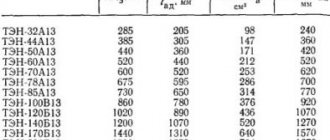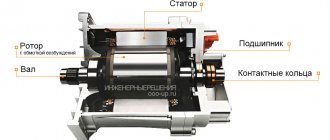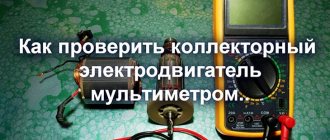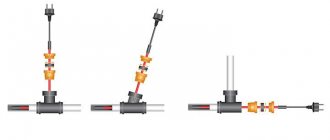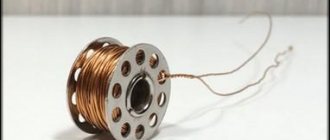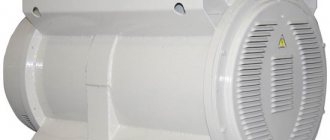Motor temperature during operation
- The main energy losses in the rotor and stator windings are directly proportional to the squares of the current values. In normal operation, the rotor and stator current is proportional to the main shaft load. All other losses do not depend on the degree of load.
- When starting the electric motor, the temperature rises unevenly. First, all the heat goes to directly increase the temperature of the electric motor and is only partially released into the environment. In this case, the temperature difference between the air and the running engine is relatively small initially.
- As the temperature increases, heat transfer to the environment increases significantly. But the temperature rise inside the engine slows down. The temperature of the electric motor is called steady when all the generated excess heat is dissipated in the environment.
- It is worth noting that the temperature of the electric motor depends on the maximum load on the shaft. A heavy load generates excess heat. After switching off, the electric motor gradually cools down.
- Electric motor heating and cooling occurs in long-term, intermittent and short-term operating modes. The permissible temperature limit is determined by the technical properties of the winding insulation.
Motor bearing lubrication
The operation of the bearing depends on the lubrication initially applied during its installation, because for a large number of electric motors, adding lubrication to the bearings after their assembly is not structurally provided.
For motors with speeds up to 3000 rpm, when lubricating bearings, it is best to use a thick lubricant such as Litol 24 (moisture resistant) or Tsiatim 201 (not moisture resistant), and for engines with higher speeds, it is better to use CIATIM-202 lubricant.
The bearing chamber of an electric motor with speeds up to 3000 rpm is filled approximately half with lubricant, and for high-speed motors the bearing chamber is filled to no more than one third of its volume.
Electric motor temperature under different operating modes
During continuous operation of the electric motor, the electric motor operates continuously at a constant ambient temperature. In intermittent mode, the operation of the electric motor alternates with periodic stops, so the temperature does not reach the set values and during the pause the electric motor is cooled to ambient temperature. The same thing happens in short-term mode.
Based on this, it can be noted that during continuous operation of the electric motor, the temperature is directly proportional to the load on the shaft. The heat capacity of an electric motor is a significant value on which the setting of the maximum permissible temperature during operation of the electric motor depends. That is why it is so important when purchasing to choose an electric motor of the required power.
Source
How to remove a bearing from an electric motor shaft
Removing a bearing from a shaft requires special pullers that vary in size and design. Massive, with three or four gripping arms, are used for large shafts of large engines; for small shafts, pullers with replaceable gripping plates or strips can be used.
The emphasis should be on the inner ring of the bearing. When rotating, you can also use a piece of pipe to extend the lever to make it easier to rotate, and you can also lubricate the shaft with machine oil to make rotation easier.
News
Any electric motor is prone to heating. Heating itself, if it is within the established limits, is not dangerous, but overheating should never be allowed. Overheating is not harmful to metal parts and bearings, but it is extremely dangerous to windings. If the temperature rises above the set limit, the insulating varnish in them begins to deteriorate, and this leads to short-circuiting of the turns.
To ensure that overheating is prevented, you need to install a temperature sensor and connect it to a circuit that breaks the power supply to the motor when the permissible temperature is exceeded. Such a protective circuit can be purchased as part of a module for thermal motor protection. In this case, it must be adjusted to the desired response temperature. This should be done in accordance with the insulation class of the electric motor. In this way, it is possible to avoid too frequent shutdowns at permissible temperatures and to protect the motor at too high temperatures.
Permissible heating temperature for electric motors of various insulation classes:
• Class Y is the least heat-resistant. Only works up to 90°C. • A - up to 105°C. • E - up to 120°C. • B - up to 130°C. • F - up to 155°C. • H - up to 180°C. • C – over 180°C
These classes are established by the National Electrical Manufacturers Association (NEMA). The class letters are not in alphabetical order. This makes them somewhat difficult to read. Therefore, when setting up a temperature sensor or checking protection systems, it is recommended to once again clarify the index in the specification.
The design of electric motors with different temperature insulation classes is the same. The only difference is the chemical composition of the insulating varnish of the windings. When assigning any heat resistance class to a varnish, it is tested at a maximum temperature for 20,000 hours. The guaranteed period of operation of the electric motor at this temperature is the same. When the temperature exceeds 10 C, the service life is halved. Another 10 C – double that. With further heating, irreversible damage to the varnish occurs. This winding needs to be replaced.
If the temperature of the windings is 10 and 20 C lower than the maximum permissible, then this has a positive effect on increasing the service life. It is about 50,000 hours or more. Therefore, during operation, electric motors must always be provided with good cooling. It must be taken into account that temperature is as dangerous a factor for electric motors as excessive mechanical loads and jamming.
Source
Factors influencing excessive bearing heating
The bearing also heats up in cases where there is no normal heat dissipation.
But the most common reason is friction that occurs between the rolling elements due to lack (excess) of lubrication. Grease is applied based on the rotational speed of the bearing. If the speed does not exceed 1500 rpm, lubricant is added to 2/3, otherwise - to 1/2 of the volume. If these conditions are not met, the bearing begins to heat up.
The second option is that the lubrication is normal, but it:
- Watered;
- Oxidized;
- Possesses mechanical contamination.
Another common reason for heating a product is misalignment of the rings, which is caused by misalignment of the mating shafts. Bearing overheating can be caused by a lack of shaft balancing. The load on the bearing increases, which leads to overheating.
The last reason is that the bearing has exhausted its service life and needs to be replaced.
Finally, bearing overheating may be due to parts that are located nearby and rubbing too much. This will lead to heating of all elements located near them.
Heat resistance classes of winding insulation
The level of permissible heating depends on the heat resistance class of the winding insulation, which is the least heat-resistant part of the structure. It is conventionally designated by the following markers:
- U - maximum temperature 90 C. Materials - paper, yarn, silk or cotton fabrics without impregnation with an insulating composition.
- A - maximum t 105 C. The materials are the same, but impregnated.
- E – maximum t 120 C. Material – synthetic organic film.
- B - maximum t 130 C. Materials - fiberglass, mica, asbestos with an organic binder.
- F - maximum t 155 C. The materials are the same as in B with a synthetic impregnating and binding agent.
- H - maximum t 180 C. The materials are the same as in B with an organosilicon impregnating and binding agent.
- C - maximum t from 180 C and above. Materials – glass, ceramics, quartz, mica with or without an inorganic binder. The permissible temperature of the electric motor during operation in this case is limited only by the properties of the insulating materials.
Temperature operating conditions of electric motors
In order for the engine to operate at rated power, the ambient temperature should not exceed 40 C. If it increases, reduce the load on the unit and ensure that the temperature of individual components does not exceed the permissible value.
The temperature of the electric motor during operation increases with an increase in the device current, which can be triggered by a decrease in the voltage in the supply network to 95% or lower. An increase in network voltage above 110% also negatively affects the temperature of the engine, since due to eddy flows the stator heats up and the current in the windings increases, causing them to overheat.
Studies show that heating the insulation for every 8 C above the permissible norm reduces its service life by half. Therefore, if you do not want the unit to fail prematurely, before you start using it, you need to find out what operating temperature of the electric motor is acceptable and strictly follow the rules, avoiding overheating and increasing current loads by more than 10%.
Source
Checking motor bearings
The condition of the motor bearings must always be checked. If their wear significantly exceeds the permissible limits, they begin to overheat, and the operation of the motor becomes noisy. If you ignore such operation of the motor and untimely replacement of the bearings, when rotating, the stationary part of the motor, the stator, and its moving part, the rotor, begin to touch each other and this can lead to serious damage to the motor and, as a result, replacement of the armature or rotor.
You can check the bearings yourself. In this case, the electric motor must be placed on a hard surface, then put your hand on top of it and turn the shaft several times. The rotor should not jam when rotating; it is also necessary to pay attention to whether there are scratching sounds or the rotor rotates with jerks, this indicates that the bearings will require replacement in the very near future.
What heats up in an electric motor?
The main source of heating is the stator winding
. Like any coil wound with wire, it gets hot. And the maximum heating temperature is limited by the temperature resistance of the winding wire insulation.
The thermal resistance of the wire is characterized by the heat resistance class parameter. For these classes, maximum temperatures are indicated by letters:
Y, A, E, B
- these classes do not tolerate temperatures above 130 degrees, now engines with such windings are practically not produced.
F - 155 gr
— this is the class with which most modern engines are manufactured
N - 180 gr
- these are special-design engines that operate in difficult conditions - for example, in hot workshops and under the scorching sun.
Maximum temperatures for classes in different reference books may vary, depending on the heating rate and conditions of use.
The second source of internal heating is bearings
. Bearings will only heat up when they are faulty or operating in extreme conditions.
Subscribe to the newsletter
The operating temperature of bearings is one of the essential operating parameters of rotating units. In addition to the dissipated thermal energy of the assembly, friction forces act on the bearings. The influence of external and internal temperature factors determines the operating temperature of the bearings , recommended by manufacturers for certain conditions of use.
In most cases, bearing heating temperatures within +65℃ are considered normal for achieving maximum service life. Increased heating up to +95℃ is taken into account in the safety margin of the bearing and should not affect its performance, although it reduces the service life. For general industrial conditions, bearing temperatures above +100℃ are dangerous and can damage them. To operate at high temperatures, bearings are installed with an internal thermal gap that compensates for the expansion of the metal of the rings and rolling elements when heated. Bearing lubricants also vary in temperature classes.
In practice, irregular overheating often occurs when the maximum temperature of the bearings is influenced by unforeseen factors. This can occur for several reasons, the likelihood of which is outlined below in descending order.
- Incorrect installation, incorrect assembly of the unit. As a result, misalignment, excessive tension, and disruption of contact surfaces ─ lead to increased friction and disruption of the normal temperature of the bearings .
- Depletion of lubricant in the bearing, or deterioration of lubricating properties due to the ingress of dust, water, and abrasive particles.
- Inappropriate amount of lubricant in bearings from unscrupulous manufacturers: insufficient filling, lack of lubrication, or vice versa, complete filling.
- Increased heating due to premature bearing wear. This often concerns such unaccounted operating factors as vibration and shock load.
- Use of a lubricant that does not correspond to the actual operating conditions or external temperature conditions.
Manufacturers use various technological options to increase the permissible temperature of bearings. Among them:
- development of effective greases for filling bearings;
- introduction of automatic supply systems for lubricating and cooling fluid;
- the use of combined heat-resistant bearing parts, for example, made of silicon nitride, fluoroplastic;
- production of precision models that combine precision and resistance to thermal expansion at high rotation speeds.
Bearing temperature monitoring
During the operation of critical rotating units in industry, energy, and aerospace transport, along with other preventive measures, the temperature of the bearings is monitored. Depending on the availability of components, the operating temperature of bearings is measured by contact and non-contact methods.
The most technically simple and widespread method is to measure the temperature of the stationary bearing ring with a hand-held thermometer with a remote probe. This option provides accuracy and measurement capability without (complete) disassembly of the unit.
To remotely measure the temperature of bearing units, infrared hand-held thermometers (pyrometers) and thermal imagers of various modifications are used. They allow you to monitor components without stopping rotation, but accurate measurements are only given when pointing at the open bearing ring. If the bearing is hidden by other parts, oil/lubricant, cover, seal, an indirect measurement of the heating of the entire assembly is made.
Automatic temperature monitoring systems include systems with sensors built into the equipment for continuous monitoring in action without human intervention.
Source
Causes of overheating
If everything is clear with the bearings, then there can be many electrical reasons. Here are some reasons for engine heating:
- phase imbalance
- low or high voltage
- phase loss (supply or inside the motor)
- turn-to-turn short circuit
- short circuit to body
- impeller failure (lack of cooling)
- high temperature of the working environment
- incorrect connection diagram
- overload in drive mechanics
In any case, the automatic motor (motor protection circuit breaker), thermal relay, posistor should not allow the engine to overheat.
How to measure engine temperature?
There are several ways.
- Hand
. Yes, the hand can tolerate temperatures up to 60 degrees, then it hurts. Tested in practice - Nose
. If the temperature is more than 80 degrees, it begins to “smell fried.” The oil begins to evaporate intensely, dust, paint, etc. smell. - Thermometer with contact sensor
. More accurate method, but may be problematic or dangerous to climb into some places - Thermometer with remote sensor (IR)
. A simpler and safer method, but there is a large error. - Thermal imager
. The best way for quick verification. The whole picture is immediately visible. - Built-in sensors.
These can be thermocouples, thermistors or posistors.
You can connect it to a temperature controller or indicator, or you can connect it to a threshold device that turns off the engine in case of an emergency. The best way to constantly and quickly monitor engine temperature.
What control method do you use?
What temperature is critical?
Of course, at an engine body temperature of +30 it will work better and longer than at +100 degrees. But both temperatures are allowed.
But up to +100 gr. you can work calmly and not worry, and after that you need to find out the reason and take action.
The rule follows from this - the electrician responsible for electrical equipment needs to regularly make rounds and check the condition of the engines and equipment as a whole.
How are you doing with this at the factory? Tell us in the comments!
Heating of electric motors insulation classes 07/10/2006 17:25
During operation, electric motors heat up. The heating temperature may be different, i.e. Some engines heat up less, others more. The value of the steady-state temperature of the engine depends on the load on its shaft. With a heavy load, a large amount of heat is released per unit time, which means that the steady-state temperature of the engine is higher. The permissible heating of electric motors depends on the insulation class of the windings.
A parameter called insulation class is also indicated on the electric motor plate with all the data.
Heat resistance is one of the most important qualities of electrical insulating materials, as it determines the permissible load of electrical machines and devices. The ability of electrical insulating materials to withstand high temperatures without harm, as well as sudden changes in temperature, is called heat resistance. You need to know that as the temperature of electric motor windings increases above permissible values, the service life of the insulation is sharply reduced. Therefore, the heat resistance of insulation is the main requirement that determines the reliability of operation and service life of an electrical machine, which should normally be 15-20 years.
| Electrical machines with class A insulation are practically not manufactured, and class E insulation finds limited use in low-power machines. They mainly use insulation of classes B and F, and in special machines operating in difficult conditions (metallurgy, mining equipment, transport) - class H. As a result of the use of more heat-resistant materials, improved properties of electrical steels and improved designs over the last 60-70 Over the past few years, it has been possible to reduce the mass of electric machines by 2.5–3 times. |
With a constant load on the shaft, a certain amount of heat is released in the engine per unit time.
Maximum permissible temperature rises of active parts of electric motors
t 0 (at ambient temperature 40ºС):
- Class E: permissible heating temperature up to 120°C.
- Class B: permissible heating temperature up to 130°C.
- Class F: permissible heating temperature up to 155°C.
- Class H: permissible heating temperature up to 180°C.
For more information about heat resistance classes of insulation, see the article Heat resistance class of insulation
The table shows, as an example, the maximum permissible temperature rises for individual parts of electrical machines of general use (O) and traction (T) during continuous operation when measuring the temperature of the windings using the resistance method (i.e., by measuring the resistance of the corresponding winding as a result of heating) , and the temperature of the commutator and slip rings using thermometers. These data correspond to an ambient temperature of +40 °C for O machines and +25 °C for T machines.
| Machine parts | Maximum permissible temperature rise, 0 C, with insulation class | |||||||||
| A | E | B | F | H | A | E | B | F | H | |
| general O | traction T | |||||||||
| Armature winding of DC machines and windings of synchronous AC machines | 60 | 75 | 80 | 100 | 125 | 85 | 105 | 120 | 140 | 160 |
| Multilayer excitation windings of DC and AC machines, compensation windings | 60 | 75 | 80 | 100 | 125 | 85 | 115 | 130 | 155 | 180 |
| Single-row excitation windings with non-insulated surfaces | 65 | 80 | 90 | 110 | 135 | 85 | 115 | 130 | 155 | 180 |
| Collectors and slip rings | 60 | 70 | 80 | 90 | 100 | 95 | 95 | 95 | 95 | 105 |
Regardless of the decrease in ambient temperature, it is not allowed to increase the current load by more than 10% of the rated value. For asynchronous motors, this can be affected by a change in the supply voltage; together with a decrease in the supply voltage, the squared power on the motor shaft decreases, and in addition, a decrease in voltage below 95% of the nominal leads to a significant increase in the motor current and heating of the windings. An increase in voltage above 110% of the nominal voltage also leads to an increase in the current in the motor windings, and stator heating increases due to eddy currents.
As the temperature rises, many of the materials begin to char and become conductors. All materials from prolonged exposure to elevated temperatures long before charring become brittle, easily destroyed and lose their insulating properties. This process is called thermal aging. Experience shows that increasing the insulation temperature by 10 °C reduces its service life by approximately half. Thus, for class A insulation, increasing the temperature from 95 to 105 °C reduces its service life from 15 to 8 years, and heating to 120 °C reduces it to two years. This phenomenon is based on the general law of the dependence of the rate of chemical reactions on temperature, described by the Van Hoff-Arenius equation.
That is, technological overloads of working machines or voltage fluctuations in the supply network lead to an increase in the current in the windings of the machines and the temperature of the windings exceeding those permissible for this class, as a result, the service life of the machines quickly decreases.
The given maximum heating temperatures for individual insulation classes cannot be fully used in practice, since under operating conditions of electrical machines and devices it is not possible to establish precise control over the insulation temperature of the most heated parts.
| Therefore, existing standards for electrical machines establish lower limits for the permissible temperatures of individual machine parts, depending on the design of these parts and their location in the machine. It is not the temperatures themselves that are regulated, but the maximum permissible temperature rise ?max, since only the temperature rise depends on the load of the machine. |
| In production conditions, temperature measurement of electrical machine components and electrical equipment is performed directly with a thermometer or indirectly based on measuring their resistance. |
The heating temperature of electric motors with power above 100 kW is controlled using built-in remote thermometers. To measure the temperature of electric motors of lower power, as well as to measure the temperature at points of electric motors where the installation of remote thermometers is impossible, portable alcohol or mercury thermometers are used. When making measurements with mercury thermometers, it should be borne in mind that in the region of alternating magnetic fields a positive error occurs, i.e. the thermometer will show an overestimated temperature value. To more accurately measure temperature, wrap the lower part of the thermometer in thin aluminum foil, crumpling it so that it fits tightly to the measurement site. The foil shell is covered with cotton wool for thermal insulation. In hard-to-reach places, measurements are carried out immediately after stopping the electric motor.
The average temperature is measured using the resistance method. It is based on the change in the resistance of a conductor with a change in its temperature. By measuring the resistance of the conductor in a cold and hot state, the temperature of the conductor is calculated.
The engine temperature rises unevenly. At first, it increases quickly: almost all the heat goes to increase the temperature, and only a small amount of it goes into the environment. The temperature difference (the difference between the engine temperature and the ambient temperature) is still small. However, as the engine temperature increases, the difference increases and heat transfer to the environment increases. The rise in engine temperature slows down.
The engine temperature stops increasing when all the newly generated heat is completely dissipated into the environment. This engine temperature is called steady state. The value of the steady-state temperature of the engine depends on the load on its shaft. With a heavy load, a large amount of heat is released per unit time, which means that the steady-state temperature of the engine is higher.
After switching off, the engine cools down. Its temperature initially drops quickly, since its difference is large, and then, as the difference decreases, it drops slowly.
The permissible steady-state temperature of the motor is determined by the insulation properties of the windings. Read more Article Heat resistance class of insulation see
At certain points in parts of the machine the temperature may be higher than average. So, for example, in open air-cooled machines, in which the frontal parts of the windings are well cooled, the slot parts heat up more than the windings. Temperature rises in individual hottest points should be no more than: 65 °C - for insulation class A, 90 °C - for insulation class B, PO and 135 °C - respectively for insulation classes F and H.
Some mechanical components and parts of electric motors are also sensitive to heat. For them, the permissible temperature rises above the ambient temperature of 35 ° C are specified in the electric motor passports. Permissible temperature rises for rolling bearings are 60°C, for plain bearings - 45°C, for steel parts of commutators and slip rings - 70°C. The temperature of journal bearings can be measured by immersing a thermometer directly into the bearing oil.
With sufficient skill, an approximate idea of the degree of heating can be obtained by touching the heated structural element with your palm (the palm without pain usually withstands temperatures of about 60°C), but it is important to remember safety first of all.
The maximum permissible temperature rises of parts of electrical machines at a temperature of the gaseous cooling medium of 40 ° C and an altitude above sea level of no more than 1000 m should be no more than the values indicated in the table. At temperatures above 40 C and altitudes above 1000 m, these values must be reduced in accordance with GOST (Rotating electric machines. General technical requirements). Direct temperature measurements using thermometers or temperature probes provide reliable results, but do not allow determining the temperature of the internal hottest parts of the winding. Based on measuring the ohmic resistance of the winding, only a certain average value of its temperature can be determined. Therefore, the norms for the maximum permissible winding temperature are indicated taking into account the method of its measurement.
You can buy an electric motor
by going to the electric motor page by clicking on it
using standard forms on the page
- using the Add to cart button and checkout from the cart
- I use the Buy in one click button
- send a request via a special form Order
- send an email
General information on electric motors
The electric motor is a key link in the mechanism, ensuring its performance. Depending on what characteristics the engine offers, the entire device as a whole will act in the same way. Electric motors cover all spheres of human activity, first of all, they are widely in demand in industry.
A synchronous electric motor is an alternating current device. The rotation frequency of the magnetic field that the armature creates is equal to the rotation frequency of the rotor.
An asynchronous electric motor is a device that operates using alternating current, converting electrical energy into mechanical energy. In this device, the rotor speed is not equal to the rotation speed of the magnetic field. Uninterrupted and reliable operation of an asynchronous motor is ensured by compliance with the necessary conditions: the altitude above sea level at which the motor operates should not exceed 1000 m; ambient temperature varies from -40 to +40 C; relative air humidity should not exceed 90% (at a temperature of +25 C), air dust content for closed engines is less than 10 mg/m3, 2 mg/m3 for protected ones.
For non-standard conditions, special engines are produced.
Explosion-proof asynchronous electric motors eliminate the possibility of explosion by enclosing the motor components that directly interact with electricity in an explosion-proof enclosure. Such a shell withstands the pressure of the explosion inside, preventing it from escaping into the environment.

